In the world of modern manufacturing, precision and efficiency are paramount. 5-axis machining centers stand at the forefront of advanced machining technology, offering unparalleled capabilities that elevate production processes. These sophisticated machines enable manufacturers to produce highly complex parts with exceptional accuracy. This article explores the power and advantages of 5-axis machining centers, shedding light on their role in shaping the future of precision machining.
What Are 5-Axis Machining Centers?
At the core of advanced machining lies the 5-axis machining center. Unlike traditional 3-axis machines, which work along three linear movements (X, Y, and Z), 5 axis machining center add two rotational axes to the mix. These two extra axes allow the cutting tool to approach the workpiece from virtually any direction, enabling the machining of complex geometries and intricate features in a single setup.
The main benefit of 5-axis machining is its ability to reduce the need for multiple setups, which not only saves time but also ensures higher precision. With the added rotational movement, manufacturers can achieve parts with more complex shapes that would be challenging or impossible with conventional 3-axis machines.
The Importance of Precision in Modern Manufacturing
Precision is crucial in today’s manufacturing environment, where even the smallest deviation can result in defects that compromise the quality and functionality of the final product. 5-axis machining centers are specifically designed to meet these high standards of accuracy. By incorporating rotational movement, they allow the cutting tool to maintain a consistent position relative to the workpiece, minimizing errors and improving overall precision.
For industries such as aerospace, automotive, and medical device manufacturing, where even micrometers can make a difference, 5-axis machining offers a level of control and reliability that is unmatched. These industries demand parts with complex geometries, tight tolerances, and flawless finishes, and 5-axis machining centers deliver on all fronts.
Increased Efficiency and Reduced Lead Time
One of the standout features of 5-axis machining centers is their ability to streamline the production process. Traditionally, complex parts would require multiple setups, often involving repositioning the workpiece several times during machining. This can lead to inefficiencies, longer production times, and potential misalignment between steps.
With 5-axis machining, however, manufacturers can perform multiple operations in a single setup, drastically reducing the need for time-consuming adjustments. This increased efficiency translates into faster lead times, allowing manufacturers to deliver products to clients more quickly while maintaining high-quality standards.
Additionally, the ability to machine multiple surfaces in one go reduces the risk of human error, ensuring that parts are produced with greater consistency.
Versatility Across Industries
The versatility of 5-axis machining centers is another key reason why they have gained widespread adoption across various industries. From aerospace and automotive to medical devices and consumer electronics, 5-axis machines can handle a wide range of materials, including metals, plastics, and composites.
Aerospace manufacturers, for example, rely on 5-axis machining to produce highly complex components like turbine blades, structural elements, and engine parts. These parts often have intricate features that require precise cutting from different angles, something that traditional 3-axis machines would struggle to achieve.
In the automotive industry, 5-axis machines are used to produce parts such as engine components, transmission housings, and custom parts for performance vehicles. Similarly, in medical device manufacturing, 5-axis machining is instrumental in creating complex surgical instruments, implants, and prosthetics.
The Role of CNC Technology in 5-Axis Machining
The integration of Computer Numerical Control (CNC) technology with 5-axis machining centers has further enhanced their capabilities. CNC allows operators to input highly detailed specifications, ensuring that the machining process is executed with the utmost precision. The sophisticated software controlling the machine enables real-time adjustments and optimization, allowing for smoother operations and reduced risk of human error.
With CNC, the programming of intricate toolpaths becomes much easier. Operators can set precise coordinates for each axis, accounting for rotations and tool movements. This level of control makes it possible to produce highly complex parts with minimal effort and maximum accuracy.
Cost-Effectiveness in the Long Run
While 5-axis machining centers tend to have a higher upfront cost than traditional 3-axis machines, they prove to be cost-effective in the long run. The reduced need for multiple setups and the ability to machine complex parts in a single operation lowers labor costs and reduces the risk of mistakes that lead to scrap material.
Additionally, the speed at which 5-axis machines can produce parts contributes to faster turnaround times. This increased efficiency enables manufacturers to take on more projects in less time, boosting overall profitability.
Moreover, the versatility of 5-axis machining allows manufacturers to work with a wide range of materials and create intricate components, opening the door to a broader customer base and new business opportunities.
Enhancing the Manufacturing Process with Automation
Another exciting advancement in 5-axis machining is the integration of automation technologies. Many 5-axis machines are now compatible with automated loading and unloading systems, which further streamline the production process. These systems can handle the transfer of parts between machines, reducing downtime and minimizing the need for manual labor.
With automation, manufacturers can achieve continuous production runs without the need for frequent human intervention. This not only increases productivity but also enhances safety, as operators can focus on monitoring the machine rather than performing manual tasks.
Challenges of 5-Axis Machining and How to Overcome Them
While 5-axis machining offers numerous benefits, it is not without its challenges. The complexity of programming these machines can be a hurdle for some manufacturers. However, advancements in CAM (Computer-Aided Manufacturing) software have made it easier to generate toolpaths and simulate machining processes. Training operators and technicians to master 5-axis programming and machine operation is essential for overcoming this challenge.
Another challenge lies in the cost of maintaining 5-axis machines, which can be more expensive to repair and service compared to 3-axis machines. However, regular maintenance and proper care can help extend the lifespan of these machines and reduce unexpected repair costs.
Future of 5-Axis Machining
As technology continues to evolve, so too does the potential of 5-axis machining centers. The next generation of 5-axis machines is expected to incorporate even more advanced features, such as increased automation, faster processing speeds, and improved materials handling capabilities. This will further enhance their precision, efficiency, and versatility, making them an even more indispensable tool for manufacturers around the world.
In addition, the integration of artificial intelligence (AI) and machine learning into the programming of 5-axis machines will allow for smarter and more adaptive manufacturing processes. AI-driven systems can analyze production data in real-time and make adjustments to the machining process, optimizing performance and reducing waste.
Conclusion
5-axis machining centers have revolutionized the world of precision manufacturing, offering unmatched accuracy, efficiency, and versatility. With their ability to machine complex geometries in a single setup, these advanced machines have become essential in industries where precision is non-negotiable. While they present challenges, such as higher upfront costs and complex programming, the benefits far outweigh the drawbacks. As technology continues to advance, the capabilities of 5-axis machining will only improve, paving the way for even more innovative manufacturing processes in the future.



